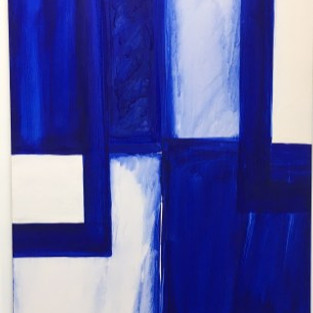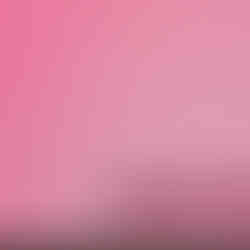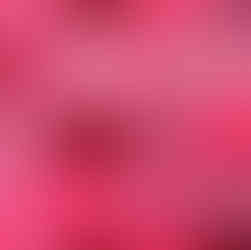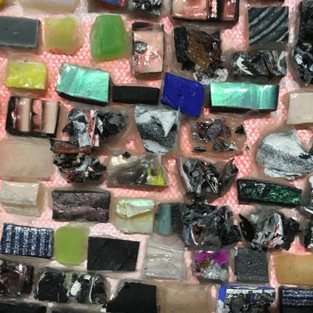Hauser & Wirth Los Angeles: Mary Heilmann, Larry Bell and Jack Whitten
- artandcakela
- Aug 6, 2018
- 6 min read

Jack Whitten, Self Portrait With Satellites at Hauser Wirth Los Angeles. Photo credit: Nancy Kay Turner
Mary Heilmann, Larry Bell and Jack Whitten
At Hauser & Wirth Los Angeles
Through September 23rd
“All genuine art is abstract “ –Suzanne Langer 1957
by Nancy Kay Turner
Hauser Wirth Los Angeles is a grand experiment, which includes a museum quality exhibition program that is free to the public, a beautiful interior urban garden, a large community gathering space and a first class unfussy restaurant. The curatorial staff mounts rigorous, intellectually stimulating and aesthetically rich shows with well-known artists alongside accomplished or eccentric artists who have flown under the radar, often due to their gender or race. This is the case with the current exhibition, which brings together 3 divergent artists – the abstract painter Mary Heilmann, the minimalist sculptor Larry Bell and the painter Jack Whitten, who of the three is lesser known.
Whitten’s body of work (entitled Self-Portraits with Satellites) is actually the most intriguing of the three and the one that was the least familiar. Much of the work has an implicit, though highly irregular, grid and the body of work is quite diverse visually. Whitten, in a recent video interview, said that he wished to create paintings without having to actually touch the painting himself. His solutions to this self-imposed problem were ingenious and very original. Though to this viewer Whitten’s paintings sometimes look like glass (and glass is used in one piece) or ceramic mosaics, they are actually bits and pieces of thickly poured and congealed cut and cast acrylic paint meticulously glued to the surface of a canvas. So in fact, the artist does not actually touch the surface with a brush. His “hand” is only evident in the cut of the individual pieces themselves. The glittering and uneven surface makes the viewer focus on the physicality of the paint itself. Whitten casts acrylic paint in ice cube trays or anything else that he could use to “direct the light.” Although he does not consider himself a narrative painter, there is often a story implicit in the works.
New York Deli: For Wayne Thiebaud (2011, acrylic on hollow door, 30” x 84”) is a personal favorite. Iridescent, glowing and lumpy donut shapes exist in a wavy field of “tiles” that simultaneously evoke the New York subway, shimmering, broken colored glass in abandoned urban spaces and Wayne Thiebaud’s luscious cake paintings. Homey as well as spectacular, this image draws the viewer in to see all the different layers and shapes close up and personal, and then sends them back out to take in the totality of the painting. Both the micro and the macro experience of the labor-intensive painting surface are thoroughly engaging for the audience.
Almost all of these works are either conceptual self-portraits or dedicated to artists, friends, family and public figures whom Whitten admires or wishes to memorialize. Such is the motivation for the The Ginsberg Mandala: For Allen Ginsberg, (1997, 29 ½“ square), which is a series of red concentric circles (all made with irregular chunky acrylic tiles) in a whitish field of hand-cut thick paint which references Ginsburg’s Buddhist religion and values. In Buddhism, The Deities are thought to be housed inside the mandala and help guide those who wish to seek enlightenment. Flat, totally abstract with a commanding presence, this piece is both mesmerizing and meditative.
One of the quirkiest and most outstanding works is the large irregular shaped painting (93” x 83”), which is entitled Self Portrait, (1996, recycled glass, black walnut, acrylic on canvas). The artist is portrayed stiffly in a frontal position with what appears to be an ascot around his neck. His round dark glass frames, dark moustache, wild mad scientist hair and his somewhat perplexed expression, along with the enigmatic truncated earth-like globe in the background, are mysterious and somewhat otherworldly. All of the works shown here (1969-2017) emphasize Whitten’s unique mosaic technique but also show an artist who was supremely interested in invention and experimentation. Becoming better acquainted with his body of work is one of the joys of this exhibit.
At the beginning of the exhibition space that houses Mary Heilmann’s work, there are two brief videos. One is a thirteen-minute digital slide projection simply entitled Her Life. Set to her favorite music, it pairs Heilmann’s paintings next to photographic fragments of landscape (no figures at all) from Northern and Southern California where Heilmann spent her youth and the early part of her career, and then ultimately to New York’s funky neighborhoods (perhaps views from her studio.) The video showcases surprising connections between the depiction of tenement windows, shutters, edges between the buildings, bits of sky, beach, waves and Heilmann’s resoundingly abstract paintings. Since so many abstract painters decry any discussion of figuration in relation to their work, it is most refreshing and brave that Heilmann embraces these references.
Her work is bold and vibrant painted in a brash style that one could argue is akin to an expressive minimalism (clearly an oxymoron). In the first room, which includes painted wood furniture and a glazed ceramic cup and saucer, the predominate color that pervades the room is bubble gum pink (or Pepto-Bismol pink lending the space a jaunty upbeat vibe). Though clearly a colorist, Heilmann’s work is about the relationships and tensions between shapes within a painting often flirting with the edges while leaving the middle vacant. La Cienega, (2010, oil on canvas 24 ¾” x 30”), is a delightful case in point. At first glance, it seems to be flat with a red square in the upper left facing off against a yellow square in the lower right. A green rectangle in the lower left is pitted against a blue rectangle on the upper right with a pink field in the middle. After awhile, it can also be seen as an aerial view of a city block with pink representing the road, with the geometric shapes as buildings. Heilmann’s paintings can look deceptively simple until one looks more closely. There are often traces of decisions underneath that are covered over but remain as visible traces. Juicy color is laid over an underneath color, creating a veil of decisions and revisions –a palimpsest. The painter’s hand is always visible here. Ming (1986, acrylic and watercolour on canvas, 60” x 42” x 1 ½”) is a case in point with its abstract expressionist drips reaffirming the flatness of the picture plane. Based on the iconic blue and white of Ming dynasty Chinese Pottery, Heilmann’s geometric composition can look like a tiny ceramic shard enlarged many times. Though tightly constructed within these demarcations, Heilmann’s paint handling is expansive and painterly as she slathers white paint over the blue under painting.

Mary Heilmann, Memory Remix at Hauser Wirth Los Angeles. Photo credit: Nancy Kay Turner.
The installation is loosely based on color relationships and the red, black and white room is one of the strongest. The stunning Chinatown (1976, acrylic on canvas, 2 parts, 83 7/8” x 54” x 2 ¾”) mimics the juicy shiny red of Chinese lacquer ware, as it references both Rothko color field paintings and architecture. There is a wonderful and quite subtle interplay of light and shadow. Heilmann has a vocabulary of shapes and relationships that she utilizes frequently in both ceramics and paintings but always with a fresh eye. Her confident work is a celebration of color and the act of happily moving paint around on a surface.
Larry Bell’s exhibit is entitled Complete Cubes, and is a retrospective of his six decades long career. The curatorial idea here is to “organize Bell’s iconic glass cubes by scale showcasing an example of every size the artist has produced from the 1960’s to the present. “ The first cube one sees is tiny – just 5 inches square – and as one walks along the cubes get slowly larger. The installation is set up almost like aisles in a jewelry store, with the cubes on pedestals designed by Bell, one right after another.
There are cubes like Untitled Cube (1970, solid barium crown glass coated with Inconel 4” square) that appear mysteriously darkened and create magical optical illusions, though some of the earliest pieces from like Untitled 19 (1964, mirrored glass, wood, mirrored base 13 “ square) show some wear and tear. Each cube represents not only a shift in scale but a shift in surface treatment. Some are iridescent, others darkened, still others have grids or ovals through which the viewer peers. Others appear bland and empty while others seem to hold secrets. The concept of serial imagery is for the artist to use the same structure and vary one element, which Bell does masterfully.
In the last room are three enormous recent works entitled RWB in Venice Fog (2018, True Se Salt, Lapis, Red Poppy and Optimum White laminated glass) each piece has 16 panels, each is 72” x 96”, and 16 panels 72” x 48 x .5”, which encase a colored cube within a larger translucent cube. The last three remind me of post-modern mausoleums, as each one seems to hold something very dear encased inside the inner chamber.
Larry Bell has said that “Spontaneity, intuition, experimentation” are essential for all good art. It is clear that what Whitten, Heilmann and Bell all have in common, besides their love of the cube and geometry, is their greater love for invention.
Hauser & Wirth Los Angeles
901 East 3rd St. Los Angeles, CA 90013
Hours: Open Tuesday – Sunday; 11am – 6pm.
#losangeles #Hauser #california #losangelesartist #art #painting #minimalistsculptor #HauserampWirthLosAngeles #losangelesart #contemporaryart #JackWhitten #painter #southerncalifornia #abstract #collage #artgallery #gallery #MaryHeilmann #museum #minimalist #artandcake #artopening #assemblage #artexhibition #installation #ArtandCakeLA #fineart #artists #artist #soloshow #mixedmedia #arts #artreview #sculpture #artmagazine #ArtandCulture #exhibition #HauserandWirth #exhibit #LarryBell #dtla #drawing


























